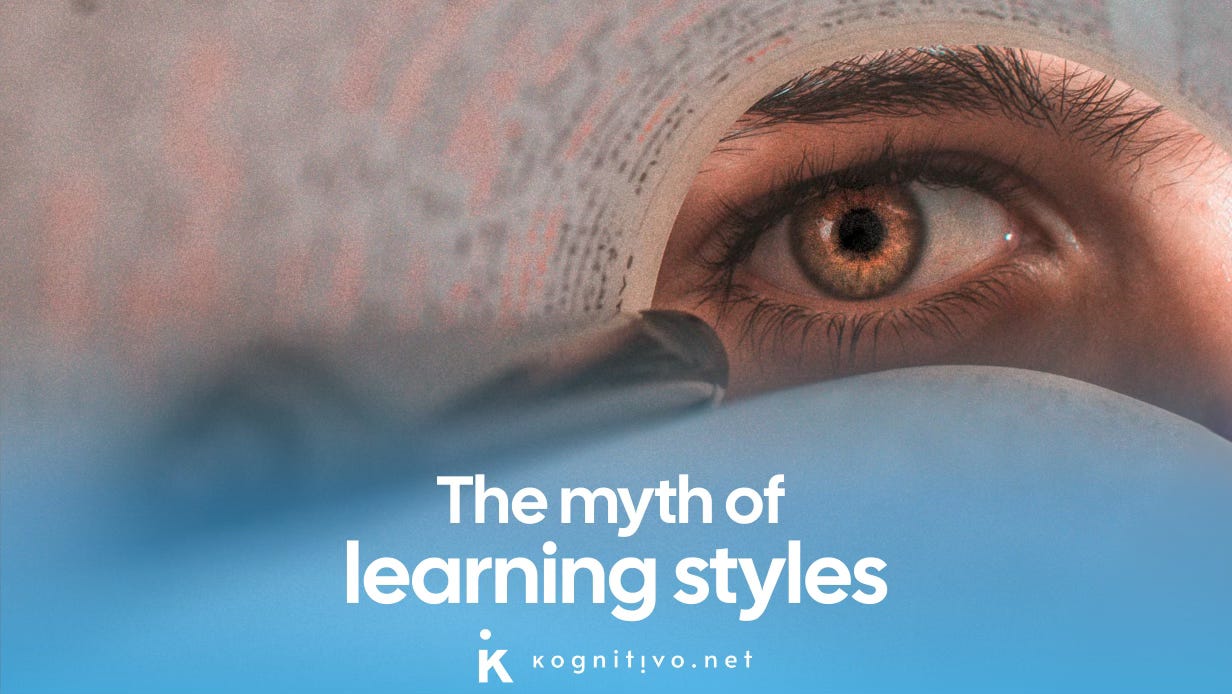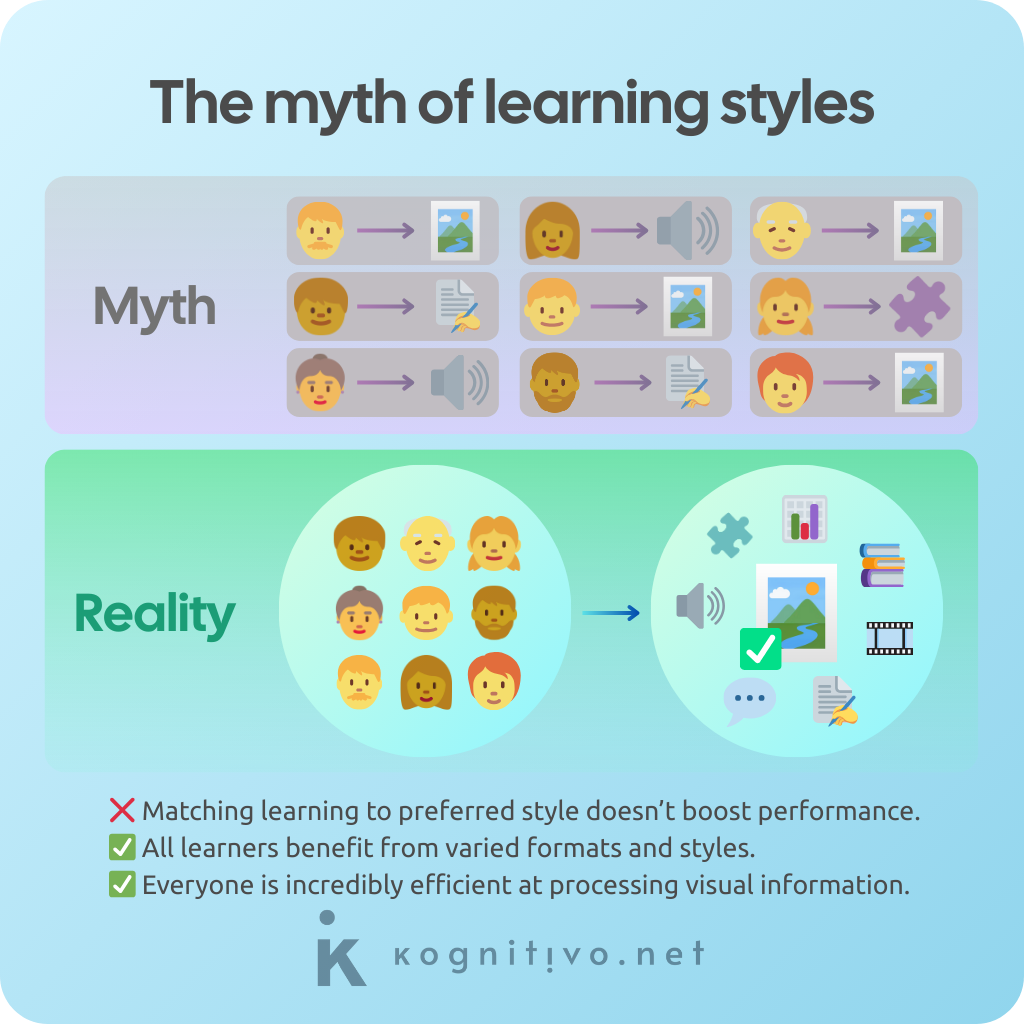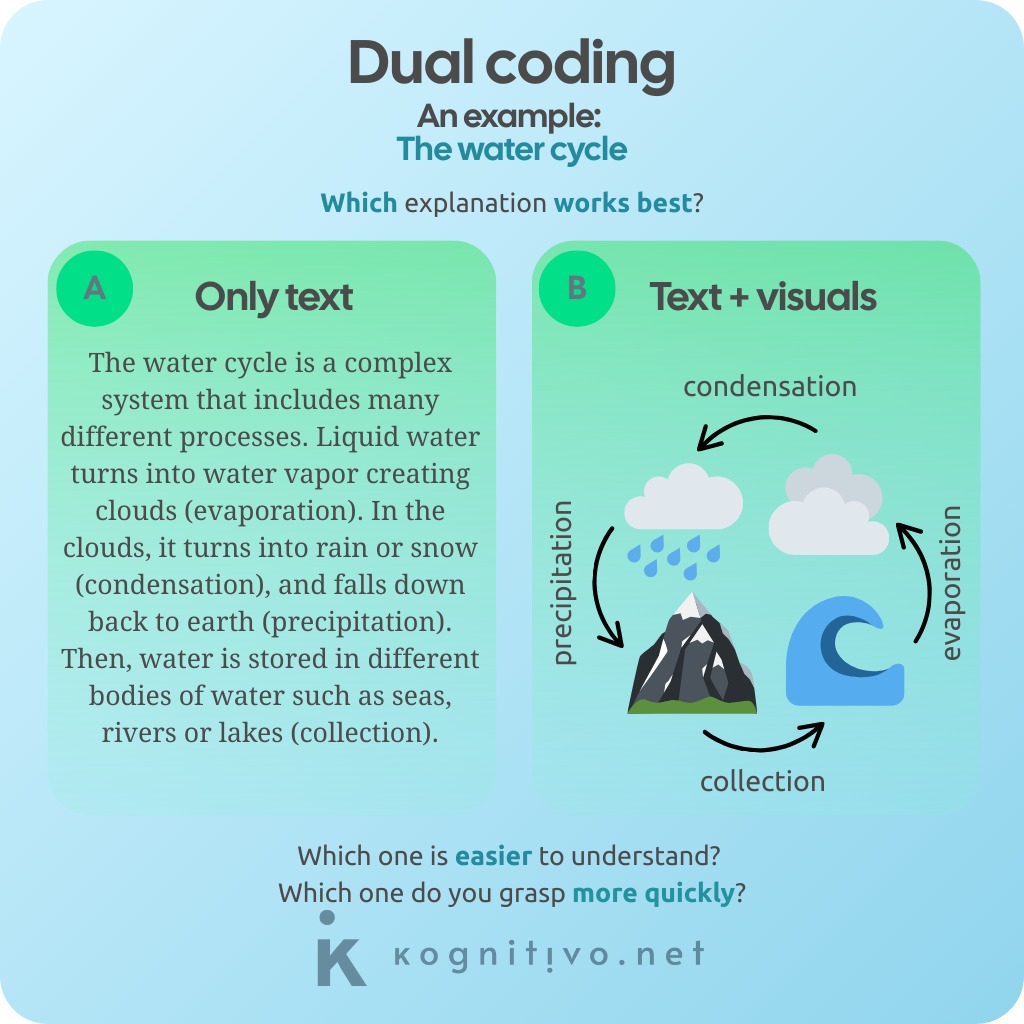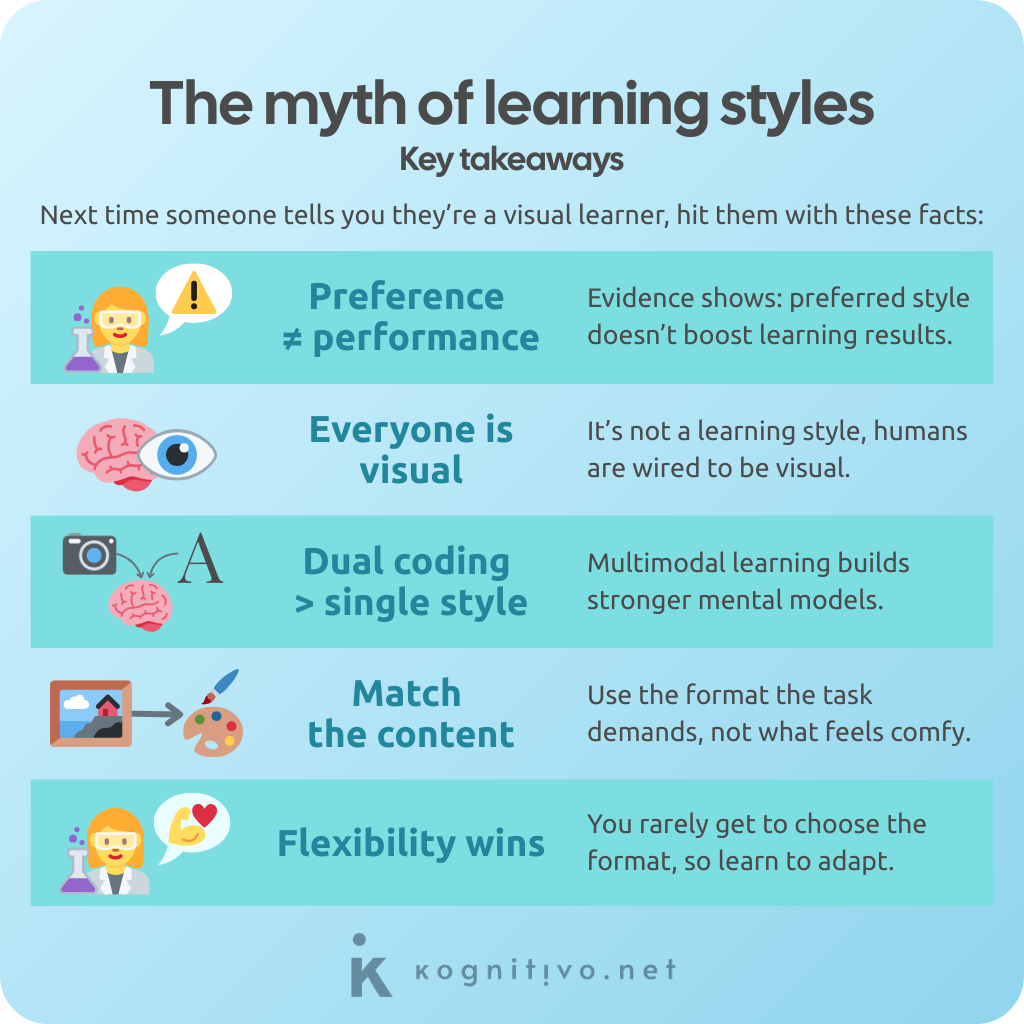You're not a visual learner, Susan: the myth of learning styles
Are you a visual learner, or an auditory one? Spoiler: you're neither. The idea of learning styles is popular, but there's no science behind it.
Before we start... 🎉 Kognitivo just hit 100 subscribers in only 30 days!
Thanks for nerding out with me. I’m ridiculously grateful (and slightly emotional).
“I’m just a visual learner,” Susan announces as she gets back the exam she didn’t pass.
She says it with half a smile, pushing her hair behind her ear as if she just cracked the code to her own intelligence. That’s why she didn’t perform well. She needs diagrams and videos. The test was made for... what are they called? “Text learners,” maybe. The teacher just doesn’t get her.
You’ve probably said or felt something like that at some point. Identifying as a specific learning style feels like self-awareness. Like finally understanding why school was so hard. The system simply didn’t match your style.
But here’s the cold, evidence-based truth: learning styles, as ways to categorize people, are mostly a myth. And clinging to that idea might be doing more harm than good.
Preferences are not performance
The core belief of learning styles is that people learn better when material matches their preferred sensory modality or cognitive style.
The idea that some learners learn best by looking at pictures, others by listening and others through hands-on activities contradicts all the scientific evidence we have. Researchers have found no consistent link between someone’s preferred learning style and their actual academic performance. In fact, teaching people in their “preferred style” doesn’t improve outcomes.
Like everyone else, you probably have your learning preferences too: you might like learning with charts rather than podcasts. But liking something isn’t the same as learning better from it.
You are a visual learner… but so is everyone else
Many people have had that moment when a diagram makes a concept click, and suddenly they think, like Susan, “Oh, I’m a visual learner.”
But here’s the unexpected truth is: everyone is. Scientists have proven that our brains are wired to process visual information incredibly efficiently, much more than text or sound alone. Visuals also help reduce the extraneous cognitive load of text-based explanations.
So yes, you’re a visual learner… Congratulations, you’re human. We are all incredibly good at processing visual input. That’s not a learning style, it’s a species trait. In fact, I’ve never heard anyone say they’re not a visual learner. Have you?
Saying “I’m a visual learner” is a bit like saying “I breathe oxygen,” as if it made you special. You‘re great at learning with visuals. So is everyone else.
Multimodal learning is the real upgrade: dual coding
If you want a real learning boost, don’t double down on your supposed style. Combine them. Research shows people retain more when they engage with material in multiple formats. Read it, say it, draw it, act it out. The technical term is “dual coding.”
Dual coding is the process of combining verbal and non-verbal information to enhance learning. By engaging both linguistic and visual channels, it creates multiple mental representations. The more access points you activate, the more neural cross-connections and paths are built in the brain: this strengthens all memory processes: encoding, retention and transfer.
Match the content, not your preference
Even if learning styles were real (they’re not), they’d be kind of useless. Because in the real world, you rarely get to choose the format.
In reality, effective learning depends on aligning the format not with your style, but with the content. You can’t master tennis by reading about it. You don’t memorize poetry with a chart. You don’t learn how to ride a bike from a podcast. Learning works best when the format fits the cognitive demands of the task.
Spatial task? Use visuals.
Conceptual reasoning? Use verbal explanation or diagrams.
Procedural skill? Use physical practice or demonstration.
You’re better off learning to adapt. Train for the real world, not just for the rare cases where it fits your preferences.
Imagine going to the gym and saying, “Sorry, I only lift with my left arm. It’s just my workout style.” That’s what clinging to a learning style sounds like.
So why does the myth stick?
This myth is incredibly resilient. A study from 2021 showed that 89% of UK teachers believe in learning styles. Research conducted in the US in 2020 found that in 29 states, government-distributed materials for teacher training referenced learning styles. Teachers love this idea.
Why? Because it’s very attractive. It seems to offer a simple way to personalize instruction. A promise of inclusion. A shortcut to motivation. And once you've labeled yourself, it becomes a tidy explanation for past struggles.
But it’s the wrong tool for a good goal.
Also, two big theories have popularized this idea, but have shaky scientific support: VARK model and Multiple Intelligences.
What this belief might be costing you
The real danger of the learning styles myth isn’t just using the wrong study technique. It’s what it trains you not to do.
Believing you have a fixed style can make you less willing to experiment, less likely to persist when something feels unfamiliar and more likely to give up when the format doesn’t suit your preference. It creates a false boundary around your potential.
This is called a self-handicapping belief: a psychological defense mechanism that protects your ego (“I failed because the format didn’t match my style”) but prevents growth.
Worse, it can discourage the use of powerful strategies like retrieval practice, spaced repetition or interleaving: simply because they feel effortful or don’t fit your preferred “style.”
In other words: the learning styles myth doesn’t just fail to help you. It might be actively making you worse at learning.
Susan, listen
Every time this topic comes up, there’s quite a bit of resistance to accepting the truth: learning styles are simply a myth.
In fact, you probably still believe that, despite everything, you know your learning style. It’s hard to change long-held beliefs, especially when they relate to our identity and have helped us make sense of our past struggles. But beliefs like this might be holding you back from unlocking your full potential.
So if you take one thing from this article, let it be an invitation to try something you never thought could work for you. You might just surprise yourself.
You’re not a visual or auditory learner. You’re a human. And humans learn best when they use all the tools available to them. Stop looking for the format that matches your identity. Start looking for the one that matches the task.
Your task now? Subscribing! What’s the learning style for that?
And remember: learning isn’t about waiting for the world to accommodate you.
It’s about your transformation to rise up and challenge it.
Keep learning
Nerd out with your favorite AI-chatbot
Prompt suggestions. Always ask follow-up questions
Act as a teacher and test me using retrieval practice on “the learning styles myth and its implications for teaching and studying.” Ask me 7 questions, one at a time, only proceeding when I answer each one. Make them progressively harder.
I’m going to be honest: after reading an article on “the myth of learning styles”, I still believe that I have a particular learning style because I’ve always learned better if I follow it. But I’m happy to discuss that. I’ll give you my reasons, please reply specifically to them and add sources to back up your replies.
What’s the actual difference between a learning preference and a learning style?
Why do so many teachers and trainers still use learning styles if the science doesn’t back them up?
Act as a curriculum designer. How would you redesign a lesson that originally targeted different “learning styles” to instead use evidence-based techniques?
Can you show me how to use dual coding or multimodal learning strategies for a complex topic I’m trying to master? (You can ask me what the topic is first.)
Links
⏯️ Learning styles and the importance of critical self-reflection: This is an incredible TED Talk on this topic by Psychology professor Tesia Marshik. She also goes into detail about the importance of giving meaning to what we learn.
📑 Learning styles: concepts and evidence: This landmark article from 2008 by Pashler and McDaniel is still today the reference on debunking learning styles. It’s an approachable and easy-to-read text. Highly recommended!
📚Multimedia Learning: In this influential book from 2001, Mayer provides 15 principles of multimedia learning on how learning works best with visuals and text. It’s a must when it comes to developing e-learning modules.







Very good. Unfortunately I still occasionally hear people mention these 😱 Thanks for including the links to the research too.